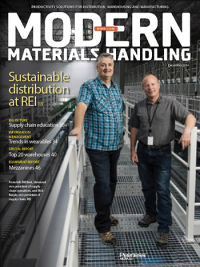Sustainable design: How the REI warehouse stands out
Craig Porter, president of The Renaissance Companies, has built distribution centers in Phoenix for some of the country’s best-known companies. Still, he says, the REI building stands out.
Latest Material Handling News
60 Seconds with Bob Trebilcock, outgoing executive editor, Modern Materials Handling Learn from lift truck service history Two voices of reason on pallet materials The reBound Podcast: How Pitney-Bowes is innovating with autonomous vehicles. Packaging Corner: Be open to change More BlogsCraig Porter, president of The Renaissance Companies, has built distribution centers in Phoenix for some of the country’s best-known companies. Still, he says, the REI building stands out.
“I can show you facilities with all kinds of technology, I’ve done facilities that were designed to show brand recognition, and I have done a LEED silver office building,” says Porter. “What made this project unique is that it brought together a high degree of technology, brand recognition and REI’s principles as a steward of the environment in one facility, and on steroids. Those three things aren’t usually addressed as a whole.”
The HVAC system is an example of REI pushing its partners to meet its goals for “sustainable design.” The challenge was two-fold. First, if the building was going to be Net Zero Energy—producing all of its energy requirements—it would need a solar array of about 340,000 square feet and the building is 390,000 square feet.
The most cost effective way to do solar is to install it on the roof, but that didn’t leave enough space for the number of roof top HVAC units needed to cool the building. And, maintaining a relatively constant temperature from the floor level to the top of the shuttle system was important because some of the items REI sells, like chocolate power bars, could melt in the Phoenix heat.
As with the materials handling suppliers, Rick Bingle, REI’s vice president of supply chain, and Bill Best, divisional vice president of supply chain operations, challenged Porter’s team to come up with an innovative solution that would meet all of their requirements.
After some research, Porter came up with an air rotation cooling system that had never been installed in Arizona. The system uses one self-contained air chiller to cool air and a series of four large air handlers installed inside the building to circulate the air. The air handlers suck in the chilled air at the ground level and blow it out at the ceiling level so that the air is constantly rotating.
“If you’re in there in August, you feel a soft flow of air,” Porter says. What’s more, the temperature varies by only 5 degrees from the ceiling to the floor, allowing storage of even temperature sensitive products anywhere in the shuttle system.
Best points out that the cooling system is a closed loop. “We’re cooling, recycling and re-cooling the air in a non-evaporative system that saves one million gallons of water a year.”
While the air conditioning system cost $1 million more to install than a conventional system, it also requires less energy, allowing for a smaller solar array than was originally planned. That saved $500,000 on the solar installation, delivering a two-year ROI on the extra money spent on air conditioning. “We were challenged to design a unique system for a unique project. That was the most interesting and fun part,” Porter says.

Article Topics
Blogs News & Resources
60 Seconds with Bob Trebilcock, outgoing executive editor, Modern Materials Handling Learn from lift truck service history Two voices of reason on pallet materials The reBound Podcast: How Pitney-Bowes is innovating with autonomous vehicles. Packaging Corner: Be open to change 60 Seconds with Robert Martichenko of American Logistics Aid Network The reBound Podcast: Looking for talent in all the right places: How Essendant is revolutionizing recruitment More BlogsLatest in Materials Handling
Registration open for Pack Expo International 2024 Walmart chooses Swisslog AS/RS and software for third milk processing facility NetLogistik partners with Vuzix subsidiary Moviynt to offer mobility solutions for warehouses Materials Handling Robotics: The new world of heterogeneous robotic integration BSLBATT is looking for new distributors and resellers worldwide Lucas Watson appointed CSO for Körber’s Parcel Logistics business in North America Hyster recognizes Dealers of Distinction for 2023 More Materials HandlingAbout the Author
Subscribe to Materials Handling Magazine

Find out what the world's most innovative companies are doing to improve productivity in their plants and distribution centers.
Start your FREE subscription today.
April 2024 Modern Materials Handling

Latest Resources











